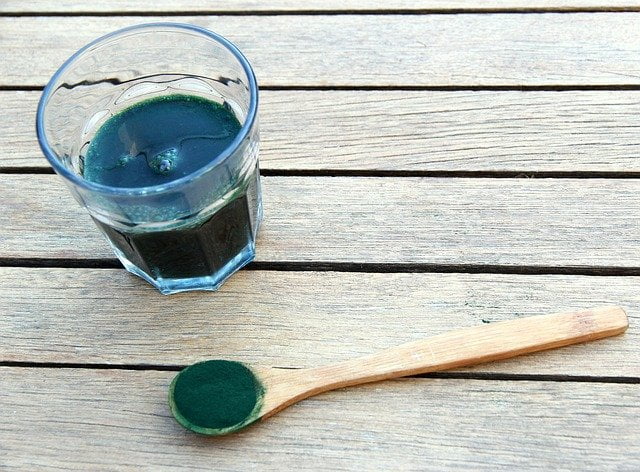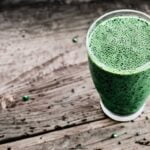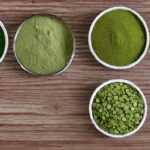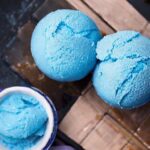Spirulina has gained in popularity over the last couple of years as a superfood. Blue spirulina is derived from green spirulina and is now found on the markets as a product as well.

In this post, we will learn about blue spirulina, what are its benefits, what it tastes like, where it can be purchased, as well as some recipes.
What is Blue Spirulina?
Blue spirulina is extracted from regular spirulina, which is a blue-green algae found growing in bodies of water. Spirulina has a green color to it, but blue spirulina has a bright blue color once extracted. This is because blue spirulina is the antioxidant that gives green spirulina its slight blue color, even though you can barely notice it.
Once extracted, blue spirulina is a bright blue color that can be used as a natural food dye, as it turns foods and smoothies into a bright blue color. You usually find it sold in powder form.
You can learn more about what blue spirulina is at What is Blue Spirulina? Here are the Benefits & Danger.
Blue Spirulina Benefits
Spirulina is very high in protein and antioxidants as well as having some B vitamins and Vitamin A, C, D, E, and K. The Intergovernmental Institution for the Use of Micro-Algae Spirulina Against Malnutrition (IIMSAM) recommends Spirulina in the fight against global malnutrition and the World Health Organization (WHO) has supported it, calling it “best food for the future” to combat malnutrition, especially in kids.
It’s high in iron and plant-based protein with 18 of 22 amino acids including all nine essential amino acids and can be safely administered to kids. It’s even been called one of the most nutritionally dense foods in the world.
But I think that is not entirely true if you look at the nutritional breakdown. Pound for pound this might be true, but you would have to consume lots of it to get the same amount of these nutrients as you can get elsewhere. The real benefits lie in the antioxidants and other qualities, that we will look at later.

Nasa has approved Spirulina as a space food due to its nutrient density and ability to be grown in space. I’ve seen that one gram of it has the same nutrient density as 1000 grams of various fruits and vegetables, but I haven’t been able to verify that yet.
Blue spirulina is also high in vitamin B12, but as we will look at later, this is actually a pseudo B12 which might have negative effects.
What is Blue Spirulina good for?
Blue Spirulina is good for many things and carries many benefits. Since green spirulina and blue spirulina are closely related, we’ll look at the benefits that could be applied to blue spirulina. Since it’s mostly green spirulina that has been studied, we’ll apply the antioxidant benefits to blue spirulina, since it is the antioxidant.
Antioxidants
These antioxidants are the reason for its success against tumors and cancers as mentioned earlier and other inflammatory conditions.

Your body goes through a process of oxidation, which produces compounds that can damage your cells and tissues including protein structures, cell membranes, and even DNA. Inflammation and oxidation can increase the risk of developing chronic diseases including cancer.
Antioxidants help to fight against this process and some of them can come from our food sources. Inflammation creates more oxidation, and more oxidation then creates more inflammation. So it’s a cycle that needs to be stopped if possible. That’s where our nutrition and healthy food sources come into work and can help.
Spirulina’s most powerful antioxidant is phycocyanin as mentioned earlier. This is what blue spirulina is. The pure phycocyanin antioxidant. (So the health benefits for spirulina will be very much the same as phycocyanin health benefits. And since it’s also blue-green algae, blue-green algae benefits will be the same as well).
Phytonutrients
Both blue and green spirulina also have lots of phytonutrients as well. You can find out more about phytonutrients here. These phytonutrients that spirulina contains are phenols, flavonoids, and polysaccharides. Just know that these phytonutrients contribute to spirulina’s anti-inflammatory and antioxidant qualities. The polysaccharides found in spirulina give it its immune-enhancing properties.
Spirulina can also increase the activity and number of microphages. These are white blood cells that can eat up pathogens and early cancer cells. Link Another benefit of blue-green algae (Spirulina) is that it increases the activity of natural hunter cells which attack viruses and tumors. It also protects cells of the immune system from damage and toxins. Study Study Study

Lower Cholesterol
Spirulina can lower total cholesterol, “bad” LDL cholesterol and triglycerides, and raise “good” HDL cholesterol. In this study and this study patients had positive impacts on cholesterol after taking Spirulina. This can lead to a lower risk of heart disease.
Furthermore, “bad” LDL cholesterol can become oxidized in the body, further leading to heart disease. Spirulina was found in studies to significantly reduce this oxidative damage, due to its antioxidants.
Anti-Cancer
As noted earlier, Spirulina has been found to have anti-cancer properties and also to fight against tumors.
Lower Blood Pressure
If you are someone who struggles with high blood pressure, Spirulina was found to lower blood pressure in individuals who were taking 4.5 grams per day. Study Study This is thought to be because of an increased production of nitric oxide in the blood, helping blood vessels to relax.
Also, the diastolic pressure is considered to be the more important reading for blood pressure, and it was found drastically reduced in those taking Spirulina.
Brain Health
As far as brain health, Spirulina has been shown to protect brain cells against damage. It has been shown to have protective effects against dementia. This is because dementia is a result of oxidative damage. Antioxidant-rich foods such as Spirulina help to combat this damage.
Liver Health
Spirulina was found to also help liver health by lowering inflammation. A study on humans helped show it reduced symptoms of fatty liver disease.
Reduce Allergies
If you are someone who suffers from allergies or asthma, Spirulina was found to help allergy suffers by lessening allergy symptoms. Spirulina suppresses the creation of Th2 cells, which contribute to inflammation.
One researcher of a study wrote, “Spirulina is clinically effective on allergic rhinitis when compared with placebo.”
Improve Anemia
For those who might have anemia, Spirulina might prove to be a help as well. In this study of older individuals with anemia, Spirulina supplementation was able to increase the hemoglobin content of red blood cells and improve the immune system.
Improves Athletic Performace

If you are an athlete, Spirulina might give you a boost by increasing endurance and greatly increasing the time it takes to fatigue.
Men who were used to jogging were able to sprint longer periods of time before fatiguing. It might be beneficial since exercise increases oxidative damage, leading to muscle fatigue, and Spirulina can help against this with its high antioxidant level.
Lowering Blood Sugar
Also, Spirulina has proven effective in lowering blood sugar levels in animals. One study on humans proved effective as well for lowering blood sugar levels a good amount.
A meta-analysis found that it was good at lowering fasting blood sugar and studies show it may improve insulin sensitivity.
Remove Heavy Metals
One final benefit is the idea that phycocyanin (Blue Spirulina) can bind with heavy metals in the body and help remove them. One study showed that Spirulina might be beneficial for those with high arsenic levels.
Here’s a quick list of all the benefits of spirulina we just covered.
- Fights free radicals in the body
- Improves the immune system
- Lower cholesterol
- Reduce blood pressure
- Anti-cancer and anti-tumor properties
- Improve and protect the brain
- Improve liver health
- Help with anemia
- Improve athletic performance, especially for endurance athletes
- Reduce blood sugar levels
- Remove heavy metals from the body
- Joint health
- Improve inflammation
Blue Spirulina Taste
Because Green Spirulina is the whole form of blue-green algae, the taste of green spirulina is a lot like algae and has a strong fishy taste and flavor. But since Blue Spirulina is extracted, Blue Spirulina has a very neutral taste.
This might be much preferable to someone who doesn’t like the stronger taste of regular spirulina. With Blue Spirulina you can get some of the spirulina benefits while having a very neutral and flavorless taste. So basically, Blue Spirulina has very little taste or just tastes like nothing at all.
This makes blue spirulina easier to take than regular spirulina. However, if you are still looking for some ways to take it, see Best Ways to Take Spirulina.
Is Blue Spirulina Natural?
Blue spirulina is natural in the sense that it is derived from a natural product, spirulina, which is found naturally in nature as a blue-green algae. So regular green spirulina is 100% natural. But, blue spirulina is not natural in the sense that it is then extracted from green spirulina in order to make blue spirulina.
This means that blue spirulina is not found naturally occurring on its own in nature.
Where To Buy Blue Spirulina
Blue spirulina can be purchased in powder form. Many different online retailers carry it, and we’ll explore some of the options where you can find blue spirulina products.
Blue Spirulina at Amazon

You can pick up Blue Spirulina in powder form fairly easily nowadays from Amazon. By doing a search I was able to find a couple of sellers, although the quality is probably unregulated. I would check the reviews at least, or go for a more reputable brand.
The average cost on Amazon tends to be about $15-$20 per ounce as of this writing. The only form it is available in is powder form as well. I’ve seen it in both organic and regular varieties. It’s hard to say which is the best blue spirulina to get, but I assume that the use of pesticides is not an issue with Spirulina growth, so I’m sure you would be fine with a regular version. You can also find the original E3Live Blue Majik Spirulina on their website. But I was able to find some of it cheaper on Amazon, sold by E3Live.
KOS Blue Spirulina
Another popular choice might be the KOS Blue Spirulina. This is an organic blue spirulina powder.
Other Places
Unicorn Superfoods has a blue spirulina powder, but they are an Australian company. So unless you live in Australia, you may have to pay extra for international shipping unless you place a big enough order to get free shipping.
Terrasoul has a blue spirulina powder on their website. Also, RawNice has a blue spirulina powder. Both are U.S. companies.
Blue Spirulina Near Me
You could also find blue spirulina near you by visiting your local health food store. I assume that most would carry it. If you shop at Whole Foods, I haven’t seen the blue spirulina available, but Whole Foods does sell the regular green Spirulina. Also, at this time Walmart does not seem to have blue spirulina as well, but they do carry green spirulina.
You might also find it for sale under the name phycocyanin powder since technically that’s what it is.
Blue Spirulina Recipes

What can you do with blue spirulina or Blue Majik in recipes? Well, for starters you could just place about 1 teaspoon into your favorite drink, to add nutritional value as well as spunky blue color!
You could also add 1 teaspoon to any light-colored foods. But don’t bake above 150 degrees Fahrenheit as this will cause the color to lose its vibrancy. Also, I don’t know if heat might destroy the nutritional value, but it’s very much possible, so I would further avoid baking anything with it.
Blue Spirulina Smoothie
You could add blue spirulina to pretty much any smoothie recipe. And since it doesn’t have a flavor it wouldn’t affect the taste and would add to the nutritional value. If you are looking to make a Blue Smoothie with the blue flavor you might need to have a specific recipe that will allow the blue color to come out.
Blue Spirulina Smoothie Bowl
Here’s an idea for a colorful smoothie bowl:
Blend together 1-2 tsp of blue spirulina powder, 2 frozen bananas, 1/2 cup of nut milk, and any additional fruit.
Common Blue Spirulina Questions
Does Blue Spirulina Have a Taste?
Blue spirulina does not have a taste. This is in contrast to green spirulina which has a fishy or aquatic taste to it.
Does Blue Spirulina Have Caffeine?
Blue spirulina does not have any caffeine and is caffeine-free.
Does Blue Spirulina Have Protein?
Blue spirulina does have some protein, but the amount is not very high. You would have to eat a lot of it in order to get a sufficient amount of protein. Instead, you can find higher sources of plant-based protein at Plant-Based Foods that are High in Protein.
Lance has been passionate about the plant-based diet and we have been following a whole food plant-based diet for over 5 years. We focus on health, natural healing, weight management, animal rights, and the health of the planet and environment by focusing on whole plant-based foods and sustainable practices.
Learn more at the About Me page and follow on social media at the links below.





